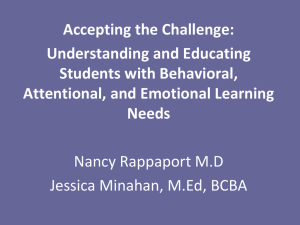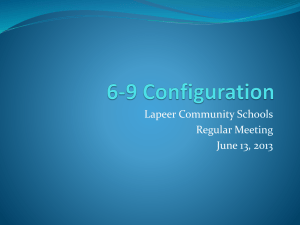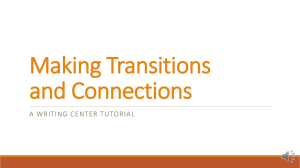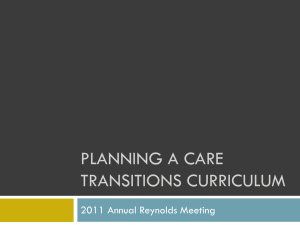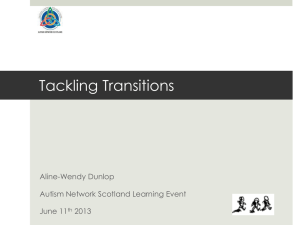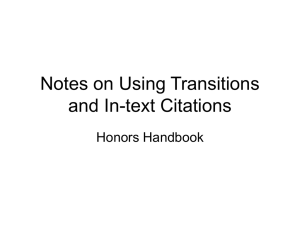Student Transitions - the Enhancement Themes website
advertisement
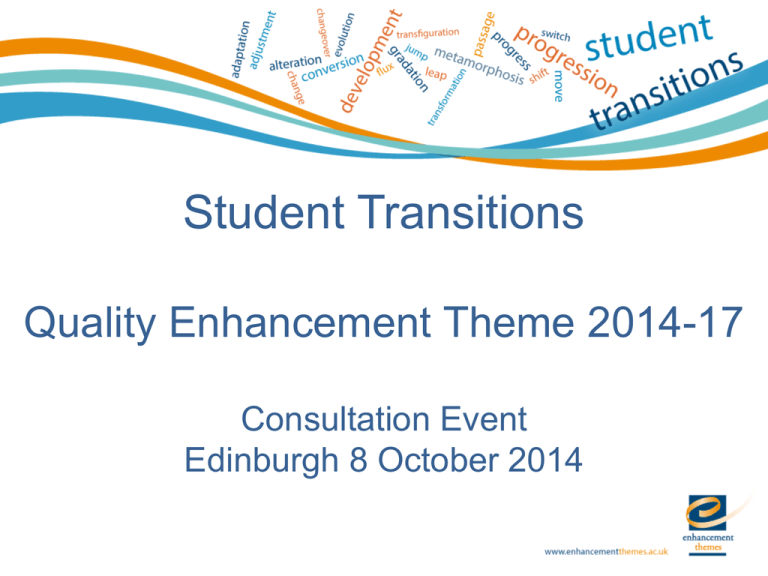
Student Transitions Quality Enhancement Theme 2014-17 Consultation Event Edinburgh 8 October 2014 Student Transitions Quality Enhancement Theme 2014-17 Professor Roni Bamber Queen Margaret University This afternoon Introduction •Enhancement Themes – what are they? •Background to this Theme – why this Theme? •Outline of Student Transitions – how are we going to do it? •Transitions – what are they about? Round table discussion Feedback Quality Enhancement Themes Topics of interest to Scottish higher education Chosen, planned and directed by the Scottish Higher Education Enhancement Committee (SHEEC) Explored and developed to enhance the quality of the student learning experience through collaboration, sharing and learning across (and beyond) the sector Funded by SFC; managed by QAA Scotland Themes website with free resources Quality Enhancement Themes Introduction •Enhancement Themes – what are they? •Background to this Theme – why this Theme? •Outline of Student Transitions – how are we going to do it? •Transitions – what are they about? Student Transitions Why this topic? •Fit with earlier Themes: Graduates for 21st Century, Developing and Supporting the Curriculum for example •Timeliness especially in relation to Curriculum for Excellence •Also •Scoping the sector through visits with institutions and SHEEC •Other evidence, eg conference evaluation question Introduction •Enhancement Themes – what are they? •Background to this Theme – why this Theme? •Outline Student Transitions – how are we going to do it? •Transitions – what are they about? Student Transitions •3 year plan of work •Central group: Student Transitions Theme Leaders Group (TLG), chaired by Prof Roni Bamber, QMU •Emphasis on institutional work •Two sectoral Tracks of work, involving external groups •Transitions at the start of a programme of study •Transitions during and at the end of a programme of study •Student Transitions Student Network: work will feed into Tracks •International element Student Transitions Outcomes will include: •Framework for transitions •Networks arising from the Tracks work •Useful resources from institutional work, collaborations, and the Tracks •Student engagement with the Theme (Theme Student Network) and practical outcomes of use to students, student associations •International engagement Student Transitions How you can be involved: •Attend this event! •Take part in Track activities •Work within HEIs – find out who is on your team •Institutional team event 4 February 2015 •Join the Enhancement Themes newsletter mailing list; LinkedIn •Propose a paper/poster/workshop – and attend - for 2nd International Enhancement Themes conference 9-11 June 2015, Glasgow Introduction •Enhancement Themes – what are they? •Background to this Theme – why this Theme? •Outline Student Transitions – how are we going to do it? •Transitions – what are they about? Student Transitions ‘The process or a period of changing from one state or condition to another’ (Oxford English Dictionary) Transitions in… Old Life New Life Provenance: School Work Disability College Student Type: WA International UG FT / PT Minority Groups (Gender, Ethnic) Transitions out… Old Life Work New Life Study abroad Other HEI Placement PG Institutional Characteristics Old Life Student Characteristics New Life Staff Characteristics Student Context Honeymoon to healthy adjustment? eg PGT Menzies and Baron, 2014 3 P Model PRESAGE: Student characteristics Teacher characteristics Learning environment Biggs, 1985 + PROCESS: What we do What students do You can control / influence some of this = PRODUCT: Learning outcomes Persistence Effective interventions Most effective pre-entry and induction interventions combine these roles: • Providing information • Informing expectations • Developing academic skills • Building social capital • Nurturing a sense of belonging Thomas, 2013 Identity, belonging and social interaction Proactive… • Community • Peer relations • Staff – student interactions • Social activities • Other? Thomas, 2013 And for students who don’t engage? Students who are not engaging are at risk of withdrawal. Identifying and following up students who are not engaging improves retention and success’ (Thomas, 2012) • Identifying them (monitoring) • Doing something about it (follow-up) Engaging Students Students engaging Engaging students Institutional Setting high characteristics expectations Presage Bamber & Jones, 2014 Teaching Feedback and assessment Identity, belonging and social interaction Process Students managing their learning Student characteristics Presage Student Transitions How to ensure we know about and share effective interventions? Round table discussion On the sheets on your table, please write down why you decided to attend today Round table discussion 1 On the dialogue sheet, start at step 1 and consider the Practice questions. Use the yellow post-its and feel free to write on the sheet as well. You have approximately 30 minutes. Round table discussion 2 Move to another table. Work through the Aspiration questions. Again, use the post-its (pink this time) and feel free to write on the sheet. You have approximately 30 minutes. Round table discussion 3 Move to another table. This time, work through the Support exercises. Use the blue post-its and write additional points on the sheet. You have approximately 30 minutes. Round table discussion 4 Move to a final table. Consider the Evaluation questions. Use the green post-its. You have approximately 15 minutes. Feedback plenary What are the three things you will take away from today? Feedback plenary What big messages do you want us to take away from today? Thank you! Enhancement Themes website: www.enhancementthemes.ac.uk

